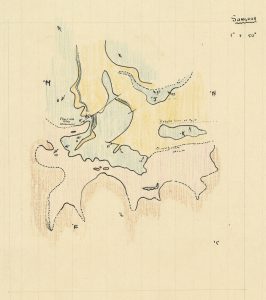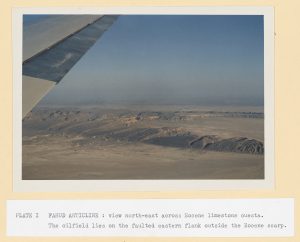May 3, 2022, by Kathryn Summerwill
Sir Peter Kent

Magazine photograph of Peter Kent with Louis Leakey and Miss Mary Nicol (later Mrs Leakey) at Olduvai Gorge, Kenya], 1935 (PK/A.72/1)
What links pleistocene sites in Kenya and Tanzania with the Forties oil field and the Lincolnshire Trust For Nature Conservation? The answer is the varied career of West Bridgford-born exploration geologist Sir Peter Kent (1913-1986).
Archaeological work
Kent studied geology at University College, Nottingham. At the age of 21 he travelled to East Africa as geologist for Louis Leakey’s fourth East African Archaeological Expedition, 1934-1935. The expedition searched for remains of Homo sapiens at Pleistocene sites at Kanam and Kanjera in Kenya, and Olduvai Gorge in Tanzania. Kent’s role as geologist was to study the rock strata to identify the age of fossils. The expedition ended in public acrimony when a rival geologist, Professor P.G.H. Boswell, cast doubt on Leakey’s previous findings and working methods. However, Kent’s appetite for fieldwork abroad was undimmed, and he spent large parts of his subsequent career far from home.
Surveying with BP
In 1936 Kent began working for the Anglo-Iranian Oil Company (later known as British Petroleum, or BP) as an Assistant Geologist. Until 1948, the focus of his work was surveying for oil in Scotland, Lancashire and Eakring in Nottinghamshire. During the war he joined the Royal Air Force Volunteer Reserve and was later seconded to the Mediterranean Allied Air Force. His work identifying German and Japanese oil plants from the air led to him being awarded the US Legion of Merit.
From the late 1940s to the late 1960s Kent travelled frequently in his capacity as geologist for Anglo-Iranian/BP. He undertook survey work in Iran, Kenya, Tanganyika [Tanzania], Papua New Guinea and Canada without much success. However, in the 1960s he and his team discovered large fields of oil and gas at Prudhoe Bay and Kuparekt in Alaska. Further glory for Kent and BP occurred in the early 1970s with the discovery of the Forties oil field in the North Sea. Kent was appointed Chief Geologist for BP in 1966 and Assistant General Manager (Exploration) in 1971.
Following his retirement in 1973, Kent continued to work as a consultant for BP on exploration matters in Iran, Canada and the UK. He also acted as chairman or director of various boards or companies concerned with oil and minerals, most notably London and Scottish Marine Oil (LASMO). Kent took up voluntary posts in various geological societies, was a Fellow of the Royal Society, and was knighted in 1973.
Peter Kent’s other interests
94 archival boxes contain papers spanning almost the whole of Kent’s life, although there is little from his salaried work with BP. He continued his own academic geological research throughout his working life. Papers relating to deep-sea drilling sit alongside his autobiography, diaries, lecture notes, conference papers, correspondence with colleagues, and minutes of many local and national organisations. Kent served on the Natural Environment Research Council (NERC) 1968-1980, and was a member of various local nature and conservation trusts. Kent’s working life in the oil and gas industry pre-dated general knowledge of greenhouse gases and the development of low-carbon technologies by some decades. Researchers are welcome to do work on his papers to find out what they contain about his wider environmental concerns at the time.
Accessing the archive
Kent’s archive collection was catalogued by the National Cataloguing Unit for the Archives of Contemporary Scientists (NCUACS) in 1993. Item-level descriptions have been available online through the National Archives’ Discovery catalogue since the early 2000s, but have only recently been added to the Manuscripts and Special Collections Online Catalogue.
The items mentioned here are available to view in the Manuscripts and Special Collections Reading Room on KMC. Please email us to make an appointment in advance, telling us when you would like to visit and the reference numbers of what you would like to see. For more information about the collections, please see our website, newsletter Discover, or follow us on Twitter and Instagram.
No comments yet, fill out a comment to be the first



Leave a Reply